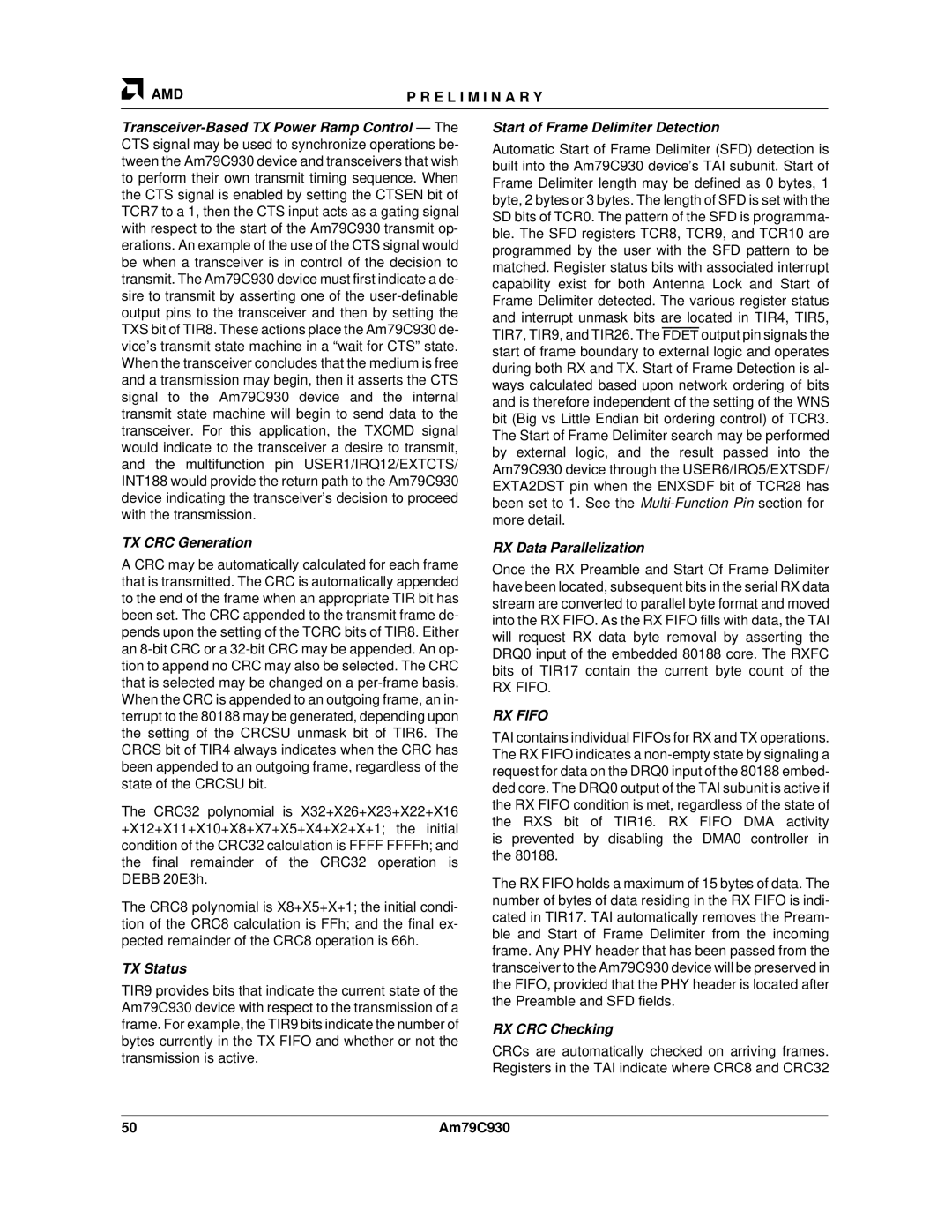
AMD | P R E L I M I N A R Y |
|
|
TX CRC Generation
A CRC may be automatically calculated for each frame that is transmitted. The CRC is automatically appended to the end of the frame when an appropriate TIR bit has been set. The CRC appended to the transmit frame de- pends upon the setting of the TCRC bits of TIR8. Either an
The CRC32 polynomial is X32+X26+X23+X22+X16 +X12+X11+X10+X8+X7+X5+X4+X2+X+1; the initial condition of the CRC32 calculation is FFFF FFFFh; and the final remainder of the CRC32 operation is DEBB 20E3h.
The CRC8 polynomial is X8+X5+X+1; the initial condi- tion of the CRC8 calculation is FFh; and the final ex- pected remainder of the CRC8 operation is 66h.
TX Status
TIR9 provides bits that indicate the current state of the Am79C930 device with respect to the transmission of a frame. For example, the TIR9 bits indicate the number of bytes currently in the TX FIFO and whether or not the transmission is active.
Start of Frame Delimiter Detection
Automatic Start of Frame Delimiter (SFD) detection is built into the Am79C930 device's TAI subunit. Start of Frame Delimiter length may be defined as 0 bytes, 1 byte, 2 bytes or 3 bytes. The length of SFD is set with the SD bits of TCR0. The pattern of the SFD is programma- ble. The SFD registers TCR8, TCR9, and TCR10 are programmed by the user with the SFD pattern to be matched. Register status bits with associated interrupt capability exist for both Antenna Lock and Start of Frame Delimiter detected. The various register status and interrupt unmask bits are located in TIR4, TIR5, TIR7, TIR9, and TIR26. The FDET output pin signals the start of frame boundary to external logic and operates during both RX and TX. Start of Frame Detection is al- ways calculated based upon network ordering of bits and is therefore independent of the setting of the WNS bit (Big vs Little Endian bit ordering control) of TCR3. The Start of Frame Delimiter search may be performed by external logic, and the result passed into the Am79C930 device through the USER6/IRQ5/EXTSDF/ EXTA2DST pin when the ENXSDF bit of TCR28 has been set to 1. See the
RX Data Parallelization
Once the RX Preamble and Start Of Frame Delimiter have been located, subsequent bits in the serial RX data stream are converted to parallel byte format and moved into the RX FIFO. As the RX FIFO fills with data, the TAI will request RX data byte removal by asserting the DRQ0 input of the embedded 80188 core. The RXFC bits of TIR17 contain the current byte count of the
RX FIFO.
RX FIFO
TAI contains individual FIFOs for RX and TX operations. The RX FIFO indicates a
The RX FIFO holds a maximum of 15 bytes of data. The number of bytes of data residing in the RX FIFO is indi- cated in TIR17. TAI automatically removes the Pream- ble and Start of Frame Delimiter from the incoming frame. Any PHY header that has been passed from the transceiver to the Am79C930 device will be preserved in the FIFO, provided that the PHY header is located after the Preamble and SFD fields.
RX CRC Checking
CRCs are automatically checked on arriving frames. Registers in the TAI indicate where CRC8 and CRC32
50 | Am79C930 |
